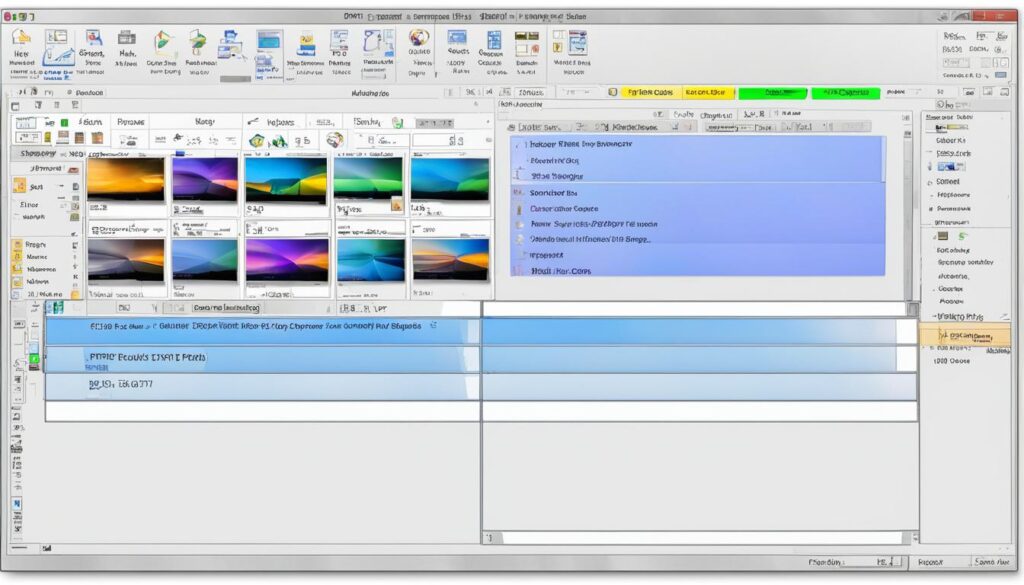Are you familiar with the term “PST” in information technology? If not, don’t worry! In this article, we will delve into what PST means in the IT world and its significance for managing email data. So, let’s get started!
A PST (Personal Storage Table) file, also known as an Outlook Data File, is used in information technology to store messages and other Outlook items. It plays a crucial role in managing email accounts, allowing users to store email data on their own computers. PST files are commonly used in Microsoft Outlook and other email programs, offering a convenient way to access and organize emails, contacts, calendar events, and more.
Contents
- 1 PST File Format and Usage
- 2 Benefits and Usage of PST Files
- 3 Managing PST Files and Locations
- 4 Converting and Opening PST Files
- 5 Importance of PST File Security
- 6 Challenges and Solutions for PST Files
- 7 Conclusion
- 8 FAQ
- 8.1 What is PST in Information Technology?
- 8.2 What is the meaning of PST in IT?
- 8.3 What is the definition of PST?
- 8.4 What is a PST file in IT?
- 8.5 What is the format of a PST file?
- 8.6 What is the file extension of a PST file?
- 8.7 What is the difference between PST and OST files?
- 8.8 What are the benefits of using PST files in Outlook?
- 8.9 Is there a file size limit for PST files in Outlook?
- 8.10 How can I open a PST file in Outlook?
- 8.11 How can I backup my PST file?
- 8.12 Where are PST files located?
- 8.13 How should I manage my PST files?
- 8.14 Can I open a PST file in other email programs?
- 8.15 How can I convert a PST file to another format?
- 8.16 How can I ensure the security of my PST files?
- 8.17 What can I do if my PST file is corrupted?
- 8.18 What are the challenges associated with PST files?
- 8.19 Are there solutions for repairing PST files?
- 9 Source Links
Key Takeaways:
- A PST file is an Outlook Data File used in information technology to store email messages and other Outlook items.
- PST files are saved on the user’s computer, providing local storage for email data.
- They are commonly used in Microsoft Outlook and other email programs.
- PST files allow users to access and manage their emails, contacts, and calendar events conveniently.
- Understanding PST files is essential for effectively managing email accounts in the IT realm.
PST File Format and Usage
When it comes to managing email accounts in IT, PST files are a crucial component. Created by Outlook, these files have a .pst file extension and serve as a storage solution for different email account data. They are incredibly versatile, allowing users to back up or export items from any type of email account.
However, it’s important to note that PST files have a file size limit, and they can grow quite large over time. This can impact the performance of your email program. On the other hand, OST files are used for different types of accounts in Outlook. These files store synchronized copies of mailbox information on the local computer, ensuring data consistency.
Let’s take a closer look at the key differences between PST and OST files in the table below:
| Feature | PST File | OST File |
|---|---|---|
| File Extension | .pst | N/A |
| Usage | Backup or export items from any email account | Store synchronized copies of mailbox information |
| File Size Limit | Yes | No |
It’s essential to understand the distinctions between PST and OST files when managing your email accounts. Now that you have a better understanding of the PST file format and its usage, let’s explore the benefits and practical applications of PST files in the next section.
Benefits and Usage of PST Files
PST files, commonly associated with Outlook, offer numerous benefits for users in managing their email data. These files allow for local storage of emails, freeing up space in the mailbox on the mail server. Here are some key advantages of using PST files:
- Local Storage: By saving emails, contacts, and calendar events in PST files, you can reduce the storage burden on the mail server, ensuring efficient email management.
- Offline Access: PST files can be opened in Outlook and other email programs, enabling users to access their archived emails even when they are offline. This feature is especially useful when traveling or in areas with limited internet connectivity.
- Data Backup: PST files serve as a convenient backup option for your email accounts. You can regularly back up your PST files to prevent data loss due to hardware failures, software issues, or accidental deletion.
- Email Account Size Limit: Email accounts often have size limits, and exceeding these limits can result in issues such as undelivered emails. By utilizing PST files, you can limit the size of your email accounts, preventing any potential problems.
“PST files provide local storage, offline access, data backup, and help in managing email account size limits.”
With the ability to store emails locally, access them offline, and safeguard your data through backups, PST files prove to be valuable assets for Outlook users. The flexibility and convenience they offer in managing email accounts make them an essential tool in the IT domain.
To better understand the benefits of PST files, below is a visual representation of their advantages:
| Benefit | Description |
|---|---|
| Local Storage | Saves space on the mail server |
| Offline Access | Allows access to emails even without internet connectivity |
| Data Backup | Prevents data loss through regular backups |
| Email Account Size Limit | Helps manage the size of email accounts |

By leveraging the benefits of PST files, you can enhance your email management capabilities and ensure the security of your valuable data.
Managing PST Files and Locations
Properly managing PST files is crucial to ensure the safety and integrity of your data. This section will cover the location of PST files, the importance of backups, and best practices for managing these files.
PST File Location
PST files are stored on your computer and their exact location may vary depending on the version of Outlook you are using. To locate your PST files, follow these steps:
- Open Outlook
- Go to “File” and select “Account Settings”
- In the “Account Settings” window, click on the “Data Files” tab
- You will see a list of PST files along with their file paths
Knowing the location of your PST files is essential for backup purposes and managing their storage.
PST File Backup
Regular backups of your PST files are crucial to avoid data loss. It is recommended to create backups on a regular basis, especially if you frequently receive important emails or store critical information in Outlook. By backing up your PST files, you can easily restore your data in case of accidental deletion, hardware failure, or other unforeseen circumstances.
PST File Management
Effective management of PST files involves organizing, moving, and copying them with caution to prevent potential data loss or corruption. When managing your PST files, consider the following best practices:
- Keep your PST files in a location that is regularly backed up
- Avoid storing PST files on network drives or removable storage devices, as this can lead to performance issues
- Regularly clean up and archive old emails to reduce the size of your PST files
- If you need to move or copy your PST files, exercise caution to ensure the files are not accidentally deleted or corrupted
By following these practices, you can effectively manage your PST files and mitigate the risk of data loss or corruption.

Remember, your PST files are an integral part of your email management system. Safeguarding them through proper location, backups, and management practices will help ensure the security and availability of your valuable data.
Converting and Opening PST Files
If you’ve come across a PST file and need to access its content, it’s essential to know how to open and convert it. Fortunately, there are various methods and tools available to help you accomplish this task.
Opening PST Files in Outlook and Other Programs
You can open PST files in Outlook and other programs that support this file format. Simply follow these steps:
- Launch Outlook or the desired program.
- Go to the “File” menu.
- Select “Open & Export” or a similar option.
- Choose “Open Outlook Data File” or a similar option.
- Browse and select the PST file you want to open.
- Click “OK” or “Open” to access the PST file’s content.
Additionally, Outlook Express and Microsoft Entourage also offer the option to import PST files, expanding the compatibility with different email programs.
Using PST Viewer Pro for Opening and Converting PST Files
If you’re looking for a third-party tool to open and convert PST files, PST Viewer Pro is a popular choice. This software provides a user-friendly interface and supports multiple file formats like EML, MSG, and MHT. With PST Viewer Pro, you can:
- Open and view the content of PST files without the need for Outlook or other email programs.
- Convert PST files to different formats for easy cross-platform compatibility.
Here’s a summarized view of the supported features:
| Functionality | Description |
|---|---|
| Open PST Files | Allows you to view the content of PST files even without Outlook or other email programs. |
| Convert PST Files | Enables you to convert PST files to popular formats like EML, MSG, or MHT for easy sharing and compatibility across different platforms and email clients. |

With PST Viewer Pro, you have a reliable solution for both opening and converting PST files, providing flexibility and convenience.
Another tool worth mentioning is the Stellar Converter for Outlook. It specializes in converting PST files to MBOX format, which is commonly used in various email programs apart from Outlook.
Remember to choose the method or tool that best suits your specific needs when it comes to opening and converting PST files.
Importance of PST File Security
PST files are an essential part of managing and storing personal and sensitive information in Microsoft Outlook. It is crucial to prioritize the security of these files to safeguard your data from corruption and unauthorized access. By implementing proper security measures and utilizing reliable recovery tools, you can protect your PST files and recover valuable data in case of any unforeseen incidents.
One of the significant risks associated with PST files is file corruption. A corrupted PST file can lead to loss of important emails, contacts, and other Outlook items. However, there are tools available, such as Microsoft’s Inbox Repair, that can help repair corrupted PST files and recover the lost data. By using these tools, you can prevent permanent data loss and ensure the integrity of your Outlook data.
Another aspect of PST file security is protecting them from unauthorized access. PST files contain personal and sensitive information, including emails, attachments, and calendar events. To prevent unauthorized access, it is essential to set strong passwords and regularly update them. Furthermore, storing PST files in secure locations and restricting access to authorized individuals can enhance the overall security of your data.
Here are some key measures you can take to ensure the security of your PST files:
- Create strong and unique passwords for your PST files and regularly update them.
- Store your PST files in encrypted folders or drives for an added layer of protection.
- Regularly backup your PST files to an external storage device or cloud storage to prevent data loss.
- Use reputable antivirus software to protect your computer from malware and potential threats.
- Regularly update your operating system and software to keep them secure and up-to-date.
By following these security measures, you can significantly reduce the risk of PST file corruption and unauthorized access. Prioritizing the security of your PST files ensures the safety and confidentiality of your personal and sensitive information.

In addition to implementing security measures, it is essential to have a reliable recovery plan in place. Accidental deletion, software glitches, or hardware failures can still result in the loss of PST file data. To address such scenarios, consider using data recovery software specifically designed for PST files. These tools can help you recover deleted, lost, or corrupted data, ensuring minimal disruption to your workflow and preventing potential data loss.
In summary, the security of your PST files should be a top priority to protect your personal and sensitive information. By taking proactive measures to prevent corruption and unauthorized access, and by using reliable recovery tools when needed, you can ensure the integrity and confidentiality of your Outlook data.
Challenges and Solutions for PST Files
PST files are not without their challenges. One of the main concerns is stability, as these files can become unstable and prone to errors over time. This can lead to unexpected access issues, resulting in inconvenience and frustration for users.
Another challenge with PST files is the risk of data loss if they are not backed up properly. Since these files reside on users’ local devices, any hardware failures or accidents can result in irreversible damage to the data stored within the PST file.
Fortunately, there are solutions available to address these challenges. PST file repair tools offer a convenient way to fix any stability issues or corruption within the file. These tools can scan and repair the damaged PST file, ensuring that it remains functional and accessible.
Microsoft’s Inbox Repair tool
One notable example is Microsoft’s Inbox Repair tool, also known as scanpst.exe. This tool is specifically designed to help users validate, repair, and correct problems with their PST files. It can detect and fix issues related to file corruption, errors, and inconsistencies, ensuring the file’s stability and usability.
“The Inbox Repair tool is like a reliable mechanic for your PST files. It can identify and fix any issues, giving you peace of mind and a smooth experience with your Outlook data.” – Microsoft Support
In addition to repair tools, there are various migration, storage, and recovery solutions available to optimize the management of PST files. These tools allow users to migrate data between different email platforms, efficiently store PST files in secure cloud storage, and recover lost or accidentally deleted files.
By utilizing these solutions, users can overcome the challenges associated with PST files and ensure the stability, security, and accessibility of their valuable email data.
Conclusion
In conclusion, PST files are an essential component of information technology for managing emails and data. They provide users with the convenience and flexibility to store and access their Outlook items on their computers, offering a more organized approach to managing email accounts. However, it is crucial to be mindful of the challenges and security considerations associated with PST files to ensure their proper management and protection.
PST files enable users to store messages, contacts, and calendar events from various email accounts, making it easier to access and manage their email data. With PST files, you can have a local backup of your emails, freeing up storage space on your mail server and reducing the risk of data loss. Additionally, PST files allow for offline access to archived emails, ensuring that you can retrieve important messages even without an internet connection.
While PST files offer numerous benefits, it is essential to address potential challenges such as stability issues, data corruption, and security risks. Regular backups of PST files should be performed to safeguard against data loss. Moreover, using tools like Microsoft’s Inbox Repair can help repair and recover corrupted PST files. Proactive measures, such as protecting PST files from unauthorized access and practicing safe file handling, can also ensure their security.
FAQ
What is PST in Information Technology?
PST, short for Outlook Data File, is used in information technology to store messages and other Outlook items.
What is the meaning of PST in IT?
In IT, PST stands for Outlook Data File, which is used to store email messages and other Outlook items.
What is the definition of PST?
PST, or Outlook Data File, is a file format used to store data from email accounts, such as messages, contacts, and calendar events.
What is a PST file in IT?
A PST file, or Outlook Data File, is used in IT to store data from email accounts, such as messages, contacts, and calendar events.
What is the format of a PST file?
A PST file has a .pst file extension and contains data from email accounts, such as messages, contacts, and calendar events.
What is the file extension of a PST file?
A PST file has a .pst file extension and is used to store data from email accounts, such as messages, contacts, and calendar events.
What is the difference between PST and OST files?
PST files are used for storing data from email accounts in Microsoft Outlook, while OST files are used for other types of accounts and store synchronized mailbox information on the local computer.
What are the benefits of using PST files in Outlook?
PST files allow for local storage of email data, freeing up storage space on the mail server. They can be accessed offline, backed up to prevent data loss, and used to limit the size of email accounts.
Is there a file size limit for PST files in Outlook?
Yes, there is a file size limit for PST files in Outlook. It varies depending on the version of Outlook being used.
How can I open a PST file in Outlook?
To open a PST file in Outlook, go to the File menu, click on Open & Export, and choose Open Outlook Data File. Then, browse to the location of the PST file and select it.
How can I backup my PST file?
To backup your PST file, go to the File menu in Outlook, click on Open & Export, and choose Import/Export. Then, select Export to a file, choose Outlook Data File (.pst), and follow the steps to save a backup of your PST file.
Where are PST files located?
The location of PST files can vary depending on the version of Outlook. To find the file location, go to the File menu in Outlook, click on Account Settings, and choose Account Settings again. Then, click on the Data Files tab to see the file location of your PST files.
How should I manage my PST files?
It is important to manage PST files properly by regularly backing them up and exercising caution when moving or copying them to avoid data loss or corruption.
Can I open a PST file in other email programs?
Yes, PST files can be opened in other email programs that support the file format, such as Outlook Express and Microsoft Entourage. There are also third-party tools available for viewing and converting PST files to other formats.
How can I convert a PST file to another format?
There are third-party tools available, such as PST Viewer Pro and Stellar Converter for Outlook, that allow users to open and convert PST files to formats like EML, MSG, or MHT.
How can I ensure the security of my PST files?
To ensure the security of PST files, it is important to handle them with caution, perform regular backups, and take steps to protect them from corruption or unauthorized access.
What can I do if my PST file is corrupted?
If a PST file is corrupted, tools like Microsoft’s Inbox Repair can help repair the file and recover lost data. It is important to back up PST files regularly to prevent data loss.
What are the challenges associated with PST files?
PST files can face stability issues and unexpected access errors. If not backed up properly, there is a risk of data loss as they reside on users’ local devices.
Are there solutions for repairing PST files?
Yes, there are solutions available for repairing PST files, such as PST file repair, migration, storage, and recovery tools. Microsoft’s Inbox Repair tool can help validate, repair, and correct problems with PST files.




